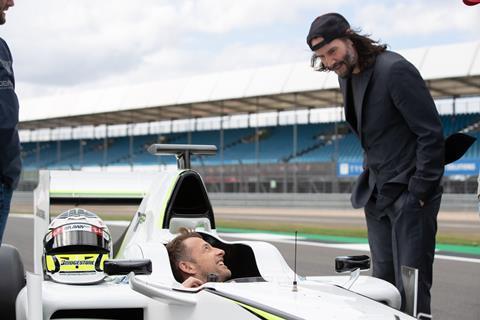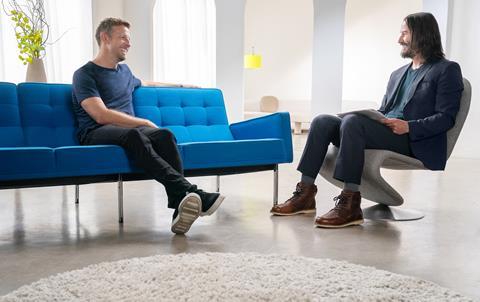Post house provided full UHD HDR Dolby Vision post-production with 5.1 Audio

Picture Shop’s Unscripted team has revealed the work that went into Disney+ docuseries Brawn: The Impossible Formula 1 Story.
The four episode series landed on the streaming platform on 15 November, and tells the story of Brawn’s unlikely victory in the 2009 F1 season - winning both the Drivers’ and Constructors’ championships despite the team being bought for just £1 before the campaign began. Host Keanu Reeves speaks to those involved in the season, including Ross Brawn, Jenson Button, Rubens Barrichello, and more, with the interviews combined with reconstructions of some of the key events that took place behind the scenes, and archival race and sync footage of the 2009 season.
It is a North One production developed, written, and produced by showrunner Simon Hammerson with executive producer Neil Duncanson alongside Reeves and directed by Daryl Goodrich. You can read more on the production here, and watch the trailer below.
The Picture Shop Unscripted team that worked on the project included colourist Alex Chernoff, online editor Stef Henley with online assistants Max Marshall and Richard Nicholson, re-recording mixer Steve Speed with sound designer Ivan Onek, and Picture Shop executive producer Yasmin Amey.
Audio
One of the initial challenges was gathering as many accurate sync sound files of the cars and races from 2009 as possible. To be able to create a detailed and immersive 5.1 mix, the first task was to provide Ivan Onek, sound designer, with enough authentic source sound clips to be able to layer and build up all the individual spot FX needed. Series editor Owen Davies at North One provided the sound team with broadcast M+E wavs from several F1 races from 2009. From those, re-recording mixer Speed auditioned and edited down over 300 clips of cars passing, crowds, and tannoy sync sounds.
Onek had just five days to complete the dialogue edit as well as the FX and sound design. To be able to create as immersive a surround mix as possible, Speed needed to balance and pan the individual elements of the separate cars on a grid and racetrack. To achieve this, Onek layered the edited archive FX, building and re-creating a soundscape for the various race sections within each episode. Car revs and grunts, individual crowd and tannoy spots were all added to enhance the original mono or stereo sync archival broadcast sound.

Speed had three days for the pre and final mix with a fourth day for the final review and sign-off. He had to work intensely to EQ and balance the dialogues, as well as the archival race and sync sounds, beds and layers of FX spots, ambience, sound design, and music. At this stage of the mix, Hammerson was based in LA, so both he and Speed would touch base and communicate ideas remotely.
The score, composed by Philip Sheppard and Baby Brown, plays a huge part in the series. Speed worked with Hammerson to create the nuance and drama that Hammerson wanted to achieve with the music. In some instances, that also involved building sections of music at the mix stage, using elements from the various music cues available. Despite having to work quickly, the process was a labor of love, and the result is a soundtrack that sounds cohesive between the two composer styles and has all the energy and drama that Hammerson was looking for.
Speed said: “From a creative perspective, working with North One and Simon Hammerson on this incredibly large and complex project was fantastic. Knowing how much everyone at Picture Shop and North One collaborated to get the series over the line made the result one which the entire team is even more proud of. As a viewer, you are not only glued to the brilliant Reeves and the journey he takes us on with Brawn but also wholly invested in the characters and events that we see unfold. It was a real privilege and intensely rewarding to work with Hammerson and the teams at North One and Disney on this project.”

Colour
Colourist Chernoff graded the series in UHD HDR using Nucoda. The biggest task was grading the archive material in a way that didn’t feel like video footage from 2009.
In Nucoda, Chernoff colour managed the footage back to a log colour space and graded it back from there, all within an HDR ACES environment. By doing this he had more control over the bottom and top end of the signal. For the onboard cameras he used Nucoda’s image processing tools to clean up some of the noise patterns, and alongside Stef Henley’s contributions in the online to clean up the interlace combing video artifacts they were able to get a good result.
Chernoff’s aim was for the interview setup to feel like paintings, flattening the backgrounds and marrying the subjects to their environments. Hammerson had a keen eye for colour and was able to communicate his vision clearly. They focused on the Brawn colours and made sure they popped whenever present in the frame.

Online edit
Online editor Stef Henley completed the UHD HDR Dolby Vision online using Autodesk Flame with online assistants Marshall and Nicholson.
The archive was an integral part of the story telling process. Close attention to detail was spent in the pre-grade online through restoring the archive and losing unwanted compression artefacts that could distract the viewer from the compelling story.
The online and grade worked very closely together alongside Hammerson to give the archive a distinct filmic look using textures and overlays that would sit in seamlessly amongst UHD HDR footage.
For some scenes, Henley heavily degraded UHD footage of Jenson Button and Ross Brawn to embed them amongst some very low-quality sourced archive scenes. Hammerson’s idea behind integrating them was to make the audience feel like they were watching a scene from 2009, which uses a visual transition from the archive effect build applied to UHD HDR to set up the following scene as present day.
Interview set-ups were cleaned up in the online for a minimalistic and clean feel, with an aim to draw subtle attention to the Brawn colours placed into the set for a continuity of colour and branding.
Henley created a high energy type-on and glitchy transition effect for the radio com subtitling that felt immersive and kept up with the intensity of the race. The font was carefully selected to feel fast and relevant with its colour sampled directly from the side of the Brawn F1 race car.
Brawn: The Impossible Formula 1 Story if available to stream on Disney+ now.








No comments yet